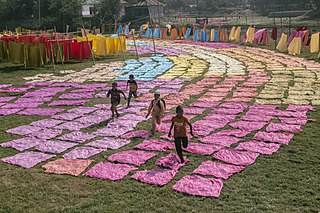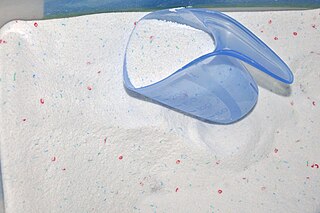Related Research Articles

A dye is a colored substance that chemically bonds to the substrate to which it is being applied. This distinguishes dyes from pigments which do not chemically bind to the material they color. Dye is generally applied in an aqueous solution and may require a mordant to improve the fastness of the dye on the fiber.

Surfactants are chemical compounds that decrease the surface tension or interfacial tension between two liquids, a liquid and a gas, or a liquid and a solid. The word "surfactant" is a blend of surface-active agent, coined c. 1950. As they consist of a water-repellent and a water-attracting part, they enable water and oil to mix; they can form foam and facilitate the detachment of dirt.
Sulfur dyes are the most commonly used dyes manufactured for cotton in terms of volume. They are inexpensive, generally have good wash-fastness, and are easy to apply. Sulfur dyes are predominantly black, brown, and dark blue. Red sulfur dyes are unknown, although a pink or lighter scarlet color is available.

Dyeing is the application of dyes or pigments on textile materials such as fibers, yarns, and fabrics with the goal of achieving color with desired color fastness. Dyeing is normally done in a special solution containing dyes and particular chemical material. Dye molecules are fixed to the fiber by absorption, diffusion, or bonding with temperature and time being key controlling factors. The bond between the dye molecule and fiber may be strong or weak, depending on the dye used. Dyeing and printing are different applications; in printing, color is applied to a localized area with desired patterns. In dyeing, it is applied to the entire textile.

In organic chemistry, quaternary ammonium cations, also known as quats, are positively-charged polyatomic ions of the structure [NR4]+, where R is an alkyl group, an aryl group or organyl group. Unlike the ammonium ion and the primary, secondary, or tertiary ammonium cations, the quaternary ammonium cations are permanently charged, independent of the pH of their solution. Quaternary ammonium salts or quaternary ammonium compounds are salts of quaternary ammonium cations. Polyquats are a variety of engineered polymer forms which provide multiple quat molecules within a larger molecule.

In chemistry, the term phosphonium describes polyatomic cations with the chemical formula PR+
4. These cations have tetrahedral structures. The salts are generally colorless or take the color of the anions.
A fabric softener or fabric conditioner is a conditioner that is applied to laundry after it has been washed in a washing machine. A similar, more dilute preparation meant to be applied to dry fabric is known as a wrinkle releaser.

In chemistry, a counterion is the ion that accompanies an ionic species in order to maintain electric neutrality. In table salt the sodium ion is the counterion for the chloride ion and vice versa.

Azo dyes are organic compounds bearing the functional group R−N=N−R′, in which R and R′ are usually aryl and substituted aryl groups. They are a commercially important family of azo compounds, i.e. compounds containing the C-N=N-C linkage. Azo dyes are synthetic dyes and do not occur naturally. Most azo dyes contain only one azo group but there are some that contain two or three azo groups, called "diazo dyes" and "triazo dyes" respectively. Azo dyes comprise 60-70% of all dyes used in food and textile industries. Azo dyes are widely used to treat textiles, leather articles, and some foods. Chemically related derivatives of azo dyes include azo pigments, which are insoluble in water and other solvents.

Laundry detergent is a type of detergent used for cleaning dirty laundry (clothes). Laundry detergent is manufactured in powder and liquid form.
A substantive dye or direct dye is a dye that adheres to its substrate, typically a textile, by non-ionic forces.

Cation–π interaction is a noncovalent molecular interaction between the face of an electron-rich π system (e.g. benzene, ethylene, acetylene) and an adjacent cation (e.g. Li+, Na+). This interaction is an example of noncovalent bonding between a monopole (cation) and a quadrupole (π system). Bonding energies are significant, with solution-phase values falling within the same order of magnitude as hydrogen bonds and salt bridges. Similar to these other non-covalent bonds, cation–π interactions play an important role in nature, particularly in protein structure, molecular recognition and enzyme catalysis. The effect has also been observed and put to use in synthetic systems.

In textile manufacturing, finishing refers to the processes that convert the woven or knitted cloth into a usable material and more specifically to any process performed after dyeing the yarn or fabric to improve the look, performance, or "hand" (feel) of the finish textile or clothing. The precise meaning depends on context.
In polymer chemistry, cationic polymerization is a type of chain growth polymerization in which a cationic initiator transfers charge to a monomer, which then becomes reactive. This reactive monomer goes on to react similarly with other monomers to form a polymer. The types of monomers necessary for cationic polymerization are limited to alkenes with electron-donating substituents and heterocycles. Similar to anionic polymerization reactions, cationic polymerization reactions are very sensitive to the type of solvent used. Specifically, the ability of a solvent to form free ions will dictate the reactivity of the propagating cationic chain. Cationic polymerization is used in the production of polyisobutylene and poly(N-vinylcarbazole) (PVK).

Paper chemicals designate a group of chemicals that are used for paper manufacturing, or modify the properties of paper. These chemicals can be used to alter the paper in many ways, including changing its color and brightness, or by increasing its strength and resistance to water. The chemicals can be defined on basis of their usage in the process.
Wet Processing Engineering is one of the major streams in Textile Engineering or Textile manufacturing which refers to the engineering of textile chemical processes and associated applied science. The other three streams in textile engineering are yarn engineering, fabric engineering, and apparel engineering. The processes of this stream are involved or carried out in an aqueous stage. Hence, it is called a wet process which usually covers pre-treatment, dyeing, printing, and finishing.

In polymer chemistry, graft polymers are segmented copolymers with a linear backbone of one composite and randomly distributed branches of another composite. The picture labeled "graft polymer" shows how grafted chains of species B are covalently bonded to polymer species A. Although the side chains are structurally distinct from the main chain, the individual grafted chains may be homopolymers or copolymers. Graft polymers have been synthesized for many decades and are especially used as impact resistant materials, thermoplastic elastomers, compatibilizers, or emulsifiers for the preparation of stable blends or alloys. One of the better-known examples of a graft polymer is a component used in high impact polystyrene, consisting of a polystyrene backbone with polybutadiene grafted chains.

Fabric treatments are processes that make fabric softer, or water resistant, or enhance dye penetration after they are woven. Fabric treatments get applied when the textile itself cannot add other properties. Treatments include, scrim, foam lamination, fabric protector or stain repellent, anti microbial and flame retardant.
Cold pad batch (CPB) is a method of dyeing textiles, typically cellulosic fibers such as cotton, in which the textile is impregnated with dye in a cold state, rather than being heated. High dye fixation and no thermal energy are the advantages of the CPB process. CPB-dyed fabrics are less expensive, have a softer hand feel, and have a cleaner surface than exhaust dyed materials. The process may take up to 12 hours in the batching process, depending on the depth of the shade. The disadvantage is that batching is a time-consuming and lengthy process. The process was developed in 1960.
In textile processing, stripping is a color removal technique employed to partially or eliminate color from dyed textile materials. Textile dyeing industries often face challenges like uneven or flawed dyeing and the appearance of color patches on the fabric's surface during the dyeing process and subsequent textile material processing stages. Stripping is one of the reprocessing methods used to correct undesirable colors and flaws in dyed materials. The efficacy of this process relies on factors such as the dye type, fiber material, and the stripping agents utilized. Additionally, the procedure is recognized by alternative terms, namely back stripping or destructive stripping.
References
- ↑ Paul, Roshan (2015). Denim: Manufacture, Finishing and Applications. Elsevier science. p. 279. ISBN 9780857098498.
- ↑ Arivithamani, Nallathambi; Giri Dev, Venkateshwarapuram Rengaswami (2018). "Characterization and comparison of salt-free reactive dyed cationized cotton hosiery fabrics with that of conventional dyed cotton fabrics". Journal of Cleaner Production. 183: 579–589. doi:10.1016/j.jclepro.2018.02.175. ISSN 0959-6526.
- ↑ Derjaguin, B. V.; Dukhin, S. S.; Rulyov, N. N. (1984), "Kinetic Theory of Flotation of Small Particles", Surface and Colloid Science, Boston, MA: Springer US, pp. 71–113, doi:10.1007/978-1-4615-7972-4_2, ISBN 978-1-4615-7974-8 , retrieved 2020-10-05
- ↑ Vostrup Senning, Rita (2019). The Etymology of Chemical Names. De Gruyter. p. 216. ISBN 9783110612714.
- ↑ Mark Marzinke, William Clarke (2020). Contemporary Practice in Clinical Chemistry. Elsevier Science. p. 146. ISBN 9780128158333.
- ↑ Gao, Yanhong; Li, Qun; Shi, Yu; Cha, Ruitao (2016-06-15). "Preparation and Application of Cationic Modified Cellulose Fibrils as a Papermaking Additive". International Journal of Polymer Science. 2016: 1–8. doi: 10.1155/2016/6978434 .
- ↑ "Cotton dyeing with indigo using alkaline pectinase and Fe(II) salt". Indian Journal of Fibre & Textile Research. 46 (1). 2021-05-17. doi: 10.56042/ijftr.v46i1.29839 . ISSN 0971-0426.
- ↑ Ru, Jidong; Qian, Xueren; Wang, Ying (2018-08-29). "Low-Salt or Salt-Free Dyeing of Cotton Fibers with Reactive Dyes using Liposomes as Dyeing/Level-Dyeing Promotors". Scientific Reports. 8 (1): 13045. Bibcode:2018NatSR...813045R. doi:10.1038/s41598-018-31501-7. ISSN 2045-2322. PMC 6115468 . PMID 30158565.
- ↑ Nallathambi, Arivithamani; Venkateshwarapuram Rengaswami, Giri Dev (2017-10-15). "Industrial scale salt-free reactive dyeing of cationized cotton fabric with different reactive dye chemistry". Carbohydrate Polymers. 174: 137–145. doi:10.1016/j.carbpol.2017.06.045. ISSN 0144-8617. PMID 28821052.
- ↑ Muthu, Subramanian Senthilkannan (2018). Sustainable Innovations in Textile Chemistry and Dyes. Singapore: Springer. p. 13. ISBN 9789811086007.